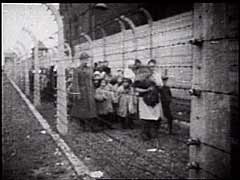

Among the 2,819 liberated Auschwitz inmates, there were 180 children; 52 of them were under 8 years of age. How could they survive this hell? They managed to survive because they were wanted for medical research instead of mice and rabbits. But the German murderers with medical degrees were only keen on a particular kind of children: they wanted to experiment on twins. Twins were a special research material of Doctor Mengele and Doctor Schmidt's. Children who did not belong to that category were simply murdered. The infants were known by the numbers on their little hands.
Among the 2,819 liberated Auschwitz inmates, there were 180 children; 52 of them were under 8 years of age. How could they survive this hell? They managed to survive because they were wanted for medical research instead of mice and rabbits. But the German murderers with medical degrees were only keen on a particular kind of children: they wanted to experiment on twins. Twins were a special research material of Doctor Mengele and Doctor Schmidt's. Children who did not belong to that category were simply murdered. The infants were known by the numbers on their little hands.
Poland
1945
[English, 1:10]
Soviet troops entered the Auschwitz camp in Poland on January 27, 1945. This Soviet military footage shows children who were liberated at Auschwitz by the Soviet army. During the camp's years of operation, many children in Auschwitz were subjected to medical experiments by Nazi physician Josef Mengele.
— National Archives - Film
Auschwitz »
Auschwitz (Abridged Article) »
Children during the Holocaust »
Children during the Holocaust (Abridged Article) »
Focus on Liberation »
Liberation of Nazi Camps »
Liberation of Nazi Camps (Abridged Article) »
Nazi Medical Experiments »
Tattoos and Numbers: The System of Identifying Prisoners at Auschwitz »